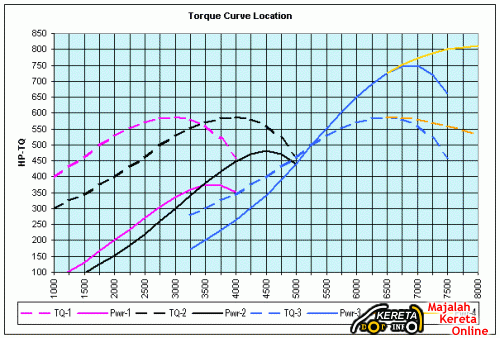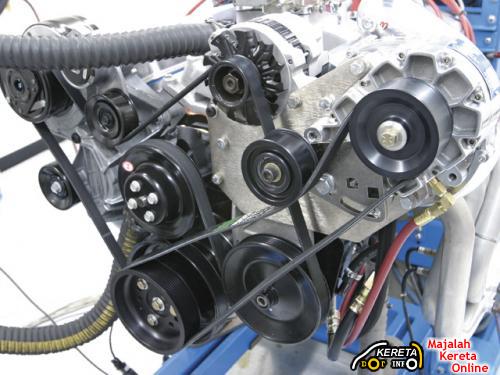Basically, it is a very subjective matter to define a truth power or an “ability” of car engines. It is very complicated because it relates to sooooo many other factors. Here we are to conclude all of the factors.
What are some of the factors? It will be the engine torque, engine rpm, Time to reach peak RPM, Fuel Consumption, Ability to have high peak power within wider range of RPM, an external factors (car weight, transmission system, car stability & aerodynamics, and too many external factors) and characteristic of dyno performance chart.
DEFINE THE TRUTH POWER OF A CAR! RELATIONSHIP OF TORQUE AND HORSEPOWER. HOW TO JUDGE THE POWER BAND RANGE?- engine dyno test
Basic calculation is:
An engine produces POWER by providing a ROTATING SHAFT which can exert a given amount of TORQUE on a load at a given RPM. The amount of TORQUE the engine can exert usually varies with RPM.
HP = Torque x RPM ÷ 5252
If you dont want to know the details about the 5252, it’s ok and it is negligible. Because it involves a longer calculation to have that 5252. But the amount is correct and the formula to calculate the horsepower also correct specially for automotive sector.
What you see in the car manufacturers catalog regarding the HP and Torque is actually a max output of the engine only. Means it is not calculated including external factors. Which we called an “engine dynamometer test“.
To have a truth result, you can go to any dyno tester and make a “Chassis Dynamometer test” to include all the external factors to determine true ability of a car. Because some manufacturer claims they have a very high HP compare to other car HP but if you test the car on track, they lose. Why? because of the external factors and the different characteristic on their dyno performance chart!
This may be lack of weight management or stability, lack of smoothness of gear transmission, higher output resistance such as higher drag or tyre friction etc. This is all depends on the overall technologies of a car to be compatible with each other’s main factors. Not the engine output only!

If you have a car with slightly lower HP, don’t worry. Your car characteristic might be different. If your torque or HP is at low RPM, it is very good for fuel economy. Means you did not have to push further to reach peak HP.
But if you have a car with higher HP, don’t be too happy. Because you may want to watch your peak RPM and torque because HP really depends on them (HP = Torque x RPM ÷ 5252). If you have higher HP at higher RPM, you need to check whether you have shorter time to reach that RPM while other car that has slightly lower HP at lower RPM already reach it’s high peak and smoked you on the track on certain speed.
But if you are able to reach high RPM faster, then you are the man! Thats what makes VTEC, VVTI and other variable valve timing so special. They allow for fuel to be burned more to helps you reach higher RPM faster. This will make you have wider RPM range for peak power. And this technologies makes your car fuel consumption more over a specified RPM to activate this stuff. Don’t complain if your car fuel consumption have an obvious wide range of lower and higher consumption.

But again, its all depends on the characteristic of a car on a dyno performance chart. A car may be driven slower 0-100kmh but they perform well over 100kmh or vice versa. Depends on settings of engine. This makes the engine tuner an important person for you to reach your target. To be a drag racer 0-100, top speed racer, or a fuel efficient car driver.
If your car is designed to be driven in a city and less fuel consumption, then high torque at low RPM is better. But if your car is designed to race, then high torque at higher RPM is better because it generates more horsepower again with the formula that moves you further in a faster time. If your car is designed to have both, then the VVT (variavle valve timing) is better for you to set your driving style. But in case of VVT, you will have lower hp at normal operating engine. You can have higher hp only if you rev up your engine up to specific RPM normally RPM 3000 and above.
HORSEPOWER HP VS TORQUE
In the end, the horsepower is more important to determine the ability of a car “BUT” it is HIGHLY dependant to how many torque an angine can produce, how fast you can go to your peak RPM and the characteristic of dyno performance chart that is more stable on a “chassis” (not engine dyno). makes it very subjective matters.
Below is the other relevan info about dyno, HP and torque:

A dynamometer determines the POWER an engine produces by applying a load to the engine output shaft by means of a water brake, a generator, an eddy-current absorber, or any other controllable device capable of absorbing power. The dynamometer control system causes the absorber to exactly match the amount of torque the engine is producing at that instant, then measures that TORQUE as well as the RPM of the engine shaft, and from those two measurements, it calculates observed power. Then it applies various factors (air temperature, barometric pressure, relative humidity) in order to correct the observed power to the value it would have been if it had been measured at standard atmospheric conditions (corrected power).
A dynamometer, also known as a dyno, is a machine used to measure RPM and torque from which power produced by an engine.
There are two types of dynos: one that is bolted directly to an engine, known as an engine dyno, or a dyno that can measure power and torque without removing the engine from the frame of the vehicle known as a chassis dyno.
Engine Dynamometer (Dyno)
An engine dynamometer measures power and torque directly from the engine’s crankshaft (or flywheel), when the engine is removed from the vehicle. These dynos do not account for power losses in the drivetrain, such as the gearbox, transmission or differential.
Chassis Dynamometer (Dyno)
A chassis dynamometer measures power from the engine through at the wheels. The car is pulled up on the dyno rollers which the car then turns and the output is measured. Chassis dynos can be installed in the ground, above ground and on trailers so they can be transported.
Due to frictional and mechanical losses in the various drivetrain components, the measured horsepower is usually 15-20 percent less than the actual horsepower measured at the crankshaft or flywheel on an engine dynamometer.
A dynamometer works by absorbing the power developed by the test engine and measuring the torque required to do so. Power is then calculated from the torque and RPM figures and proportioned to a standard horsepower
A dynamometer only measures torque and RPM and power is calculated from those measurements.
So far we’ve only been looking at an engine as a torque-producing device, but torque itself is not what causes the car to accelerate. For that you need power. The basic relationship between the two is very simple – power equals revs times torque.




Some additional info: Engine horsepower is noted as bhp(brake horsepower) or PS(Pferdestärke, means horsepower in german) and the chassis dynamometer will indicate your wheel horsepower usually noted as whp(wheel horse power) or even thp(true horsepower)=D
so good.. very informative article… thanks korang
haha..hope this helps many people to understand more on horsepower and torque. Jangan diuji kekuatannya. haha.. =p